
Scorpions are predatory arachnids of the order Scorpiones. They have eight legs, and are easily recognized by a pair of grasping pincers and a narrow, segmented tail, often carried in a characteristic forward curve over the back and always ending with a stinger. The evolutionary history of scorpions goes back 435 million years. They mainly live in deserts but have adapted to a wide range of environmental conditions, and can be found on all continents except Antarctica. There are over 2,500 described species, with 22 extant (living) families recognized to date. Their taxonomy is being revised to account for 21st-century genomic studies.
The taxonomy of scorpions deals with the classification of this predatory arthropod into 13 extant families and about 1,400 described species and subspecies. In addition, 111 described taxa of extinct scorpions are known.
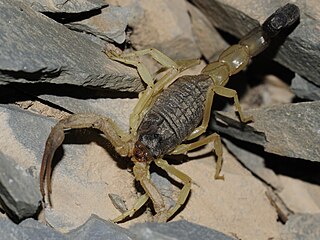
Hottentotta is a genus of scorpions of the family Buthidae. It is distributed widely across Africa, except for most of the Sahara desert. Species in the genus also occur in the Middle East, the Arabian Peninsula, southeastern Turkey, Iraq, Iran, Afghanistan, Pakistan, India, Nepal, Cape Verde Islands, and Sri Lanka (introduced).
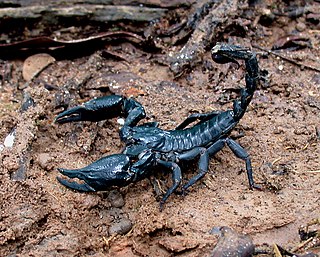
Heterometrus, whose members are also known by the collective vernacular name giant forest scorpions, is a genus of scorpions belonging to the family Scorpionidae. It is distributed widely across tropical and subtropical southeastern Asia, including Indonesia, Brunei, Malaysia, Myanmar, Philippines, Singapore, Cambodia, Laos, Thailand, Vietnam, India, and China (Hainan). It is notable for containing some of the largest living species of scorpions.
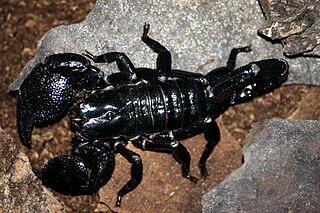
Pandinus is a genus of large scorpions belonging to the family Scorpionidae. It contains one of the most popular pet scorpions, the emperor scorpion . The genus is distributed across tropical Africa.
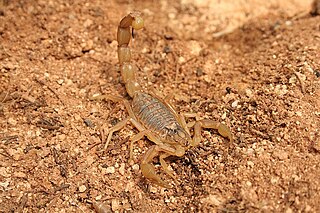
Buthus is a genus of scorpion belonging and being eponymous to the family Buthidae. It is distributed widely across northern Africa, including Morocco, Mauritania, Algeria, Tunisia, Libya, Egypt, Senegal, Guinea-Bissau, Nigeria, Sudan, Somalia, Ethiopia, Djibouti, as well as the Middle East, including Israel, Palestine, Jordan, Lebanon, Iraq, Yemen, and possibly Saudi Arabia and southern Turkey. Its European range includes the Iberian Peninsula, southern France, and Cyprus.
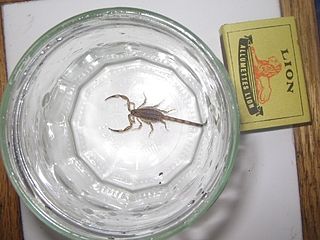
Isometrus is a genus of scorpion belonging and being eponymous to the family Buthidae. Some species are currently assigned to the genus Reddyanus.

The Chactidae are a family of scorpions established by Reginald Innes Pocock in 1893. They make up the superfamily Chactoidea.

Diplocentridae is a family of scorpions. The roughly 120 species are mostly native to the New World, except for genus Nebo, which is distributed in the Middle East.
Alpiscorpius gamma is a species of scorpion found in parts of Central and Southern Europe. Its body reaches the length of 32 mm and is darkly pigmented, but is largely indistinguishable from closely related species with which it forms the »mingrelicus complex«. The animal is not considered aggressive and has mild venom, so it is not dangerous to humans.

Scorpiops is a genus of scorpions in the family Scorpiopidae. It is distributed throughout much of Asia. The taxonomy of the group is unclear because new species and subgenera are described often, and one subgroup may represent a species complex.
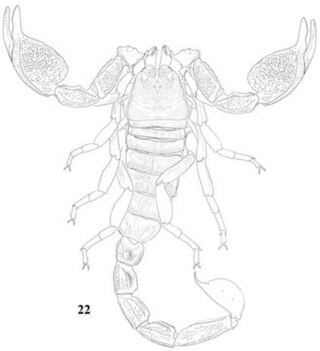
Scorpiops langxian is a species of scorpion in the family Euscorpiidae, first found in Tibet, China.

Scorpiops luridus is a species of scorpion in the Euscorpiidae family, first found in Tibet and Yunnan, China.
Euscorpiops vachoni is a species of scorpion in the Euscorpiidae family, first found in Tibet and Yunnan, China.
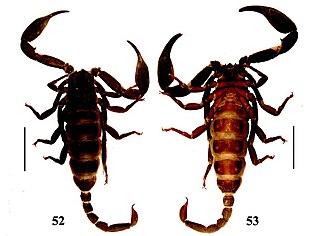
Euscorpiops shidian is a species of scorpion in the Euscorpiidae family, first found in Tibet and Yunnan, China.
Euscorpiops karschi is a species of scorpion in the Euscorpiidae family, first found in Tibet and Yunnan, China.
Chaerilus tessellatus is a species of scorpion in the Chaerilidae family, first found in Tibet and Yunnan, China.

Reddyanus is a genus of buthid scorpions native to Oriental region from India, Sri Lanka, China: Tibet, to Melanesia. The genus was previously described as a subgenus of Isometrus.
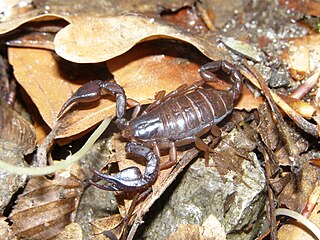
Euscorpius carpathicus is a species of scorpion endemic to the Romanian Carpathians. It is the type species of the genus Euscorpius.

Euscorpius avcii is a species of scorpion in the family Euscorpiidae. It was described by Tropea et al. in 2012.














